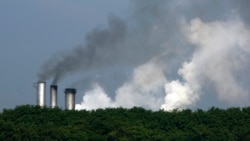To combat climate change, the American space agency NASA has launched an instrument to measure global carbon and methane levels.
The instrument is attached to a satellite called Tanager-1. It launched on August 16 aboard a SpaceX Falcon 9 rocket from NASA’s Vandenberg Space Force Base in California. Ground control reported that they successfully established communication with the satellite shortly after launch.
A NASA statement said the satellite is equipped with a gas detector that uses “imaging spectrometer technology.” A spectrometer is an instrument used to study the chemical composition and structure of substances.
NASA’s Jet Propulsion Laboratory (JPL) developed the imaging spectrometer. Other organizations also participated in the joint project, including Planet Labs PBC, a private company that helped build the Tanager-1 satellite.
Tanager-1 is one of two satellites developed as part of the public-private partnership Carbon Mapper Coalition. The other satellite has not yet been launched.
The coalition wants to support the collection of detailed data on methane and carbon dioxide. Emissions worldwide. The coalition hopes to use the data to reduce methane and carbon pollution. Scientists have linked carbon and methane emissions to rising temperatures on Earth. Many climate experts blame most of the warming on pollution caused by human activities.
According to NASA, the instrument on board Tanager-1 measures “hundreds of wavelengths of light that reflected from the Earth’s surface.” Using this method, the instrument can find carbon and methane sources based on the wavelengths of light they emit.
The process creates “fingerprints” that the imaging spectrometer can identify, NASA said. This data can be used to provide highly detailed information about where the world’s carbon and methane came from. The level of detail is so precise that it can even identify “individual Facilities and equipment,” the space agency added.
Laurie Leshin is director of the Jet Propulsion Laboratory (JPL) based in Pasadena, California. In a statement, she said the imaging spectrometer technology is the product of more than 40 years of development work at NASA. Leshin said such detailed emissions data could help policymakers, governments and environmental organizations around the world.
When fully operational, Tanager-1 is expected to collect data from 130,000 square kilometers of Earth’s surface every day, allowing scientists to identify specific gas clouds that release carbon dioxide and methane. NASA said the data collected would be publicly available online on the Carbon Mapper data portal.
According to NASA, about half of the world’s methane emissions are due to human activities. The biggest polluters are the so-called “super Emitter,” said Riley Duren, executive director of the Carbon Mapper Coalition. He told Reuters that super emitters produce more than 100 kilograms of methane per hour. That amount of emissions can account for 20 to 60 percent of an area’s total emissions in some industries, Duren said.
In addition, the agency noted: “There is 50 percent more carbon dioxide in the atmosphere today than in 1750, an increase largely due to the extraction and the combustion of coal, oil and (natural) gas.”
Duren said in a statement that the Carbon Mapper Coalition is a good example of “how organizations from different Industries unite around the common goal of tackling climate change.” He added that the ability to accurately identify the sources of carbon and methane “can immediately spur meaningful action to reduce emissions around the world.”
The launch of Tanager-1 comes after NASA launched the PACE satellite in February. It is designed to study the world’s oceans and atmosphere in detail. PACE stands for Plankton, Aerosol, Cloud, Ocean Ecosystem. The satellite will study the environment from an orbit 676 kilometers above the Earth’s surface for at least three years.
I’m Bryan Lynn.
Bryan Lynn wrote this story for VOA Learning English, based on reporting from Reuters, NASA and the Carbon Mapper Coalition.
_____________________________________________
Words in this story
emission – N. the act of emitting something such as gas, heat or light
reflect – N. return or reject something
Furnishings – N. the place where a particular activity takes place
emit – V. Release gas, heat, light, etc. into the air
extract – V. take something out, especially by force
sector – N. a part of a country’s economy


